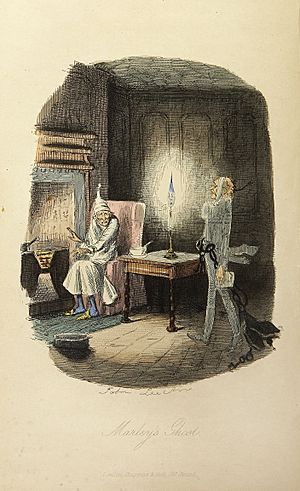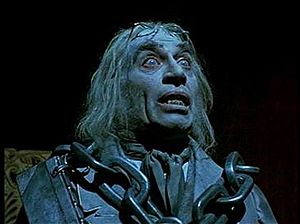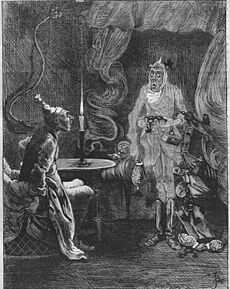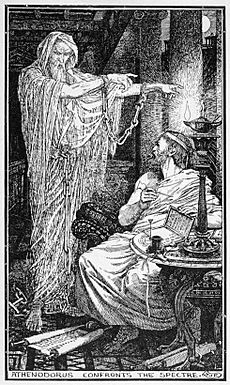Jacob Marley facts for kids

Jacob Marley is a made-up character in Charles Dickens's famous story A Christmas Carol, written in 1843. He was the business partner of the very stingy Ebenezer Scrooge. Marley was known as a "good man of business."
At the start of the story, on Christmas Eve, Marley has been dead for seven years. His ghost visits Scrooge to give him a serious warning. Marley tells Scrooge that three other Spirits will visit him. These Spirits will give Scrooge a chance to change his ways and become a better person.
Contents
Why Marley is Important to the Story

In early 1843, Charles Dickens was very worried about how poor people were treated. He was especially upset about children working in terrible conditions. He saw kids working in a tin mine and visited a school for very poor children.
Dickens first wanted to write a political leaflet. It was going to be called An Appeal to the People of England, on behalf of the Poor Man's Child. But he changed his mind. Instead, he wrote A Christmas Carol. This story shared his concerns about poverty and unfairness.
Jacob Marley's ghost in the first part of the story helps Dickens share his message. Marley and Scrooge had been business partners for many years. They were very similar. Both were obsessed with money and didn't care about other people.
Marley died without being punished for his lack of kindness. But after death, he is forced to wander the Earth. He is weighed down by chains, cash boxes, and ledgers. He desperately wants to help the poor but cannot.
On the seventh Christmas Eve after his death, Marley's ghost appears to Scrooge. He is suffering greatly. Marley looks just as he did in life, with his pigtail and old clothes. But he is wrapped in a long chain. This chain is made of cash-boxes, keys, padlocks, and heavy purses. His body is see-through, so Scrooge can see right through him.
Marley warns Scrooge that his own chain was just as heavy seven years ago. Scrooge's chain has grown much heavier since then because of his unkindness. To avoid suffering forever, Scrooge must change his life.
Marley tells Scrooge that he arranged for three Spirits to visit him. These Spirits will give Scrooge a chance to escape Marley's sad fate. Marley warns Scrooge to expect the first Spirit at one o'clock. The second will come the next night at the same time. The third will appear on the third night at midnight.
Marley tells Scrooge he will not see him again. He then leaves through the open window. Outside, he joins other suffering souls. They are also tormented because they failed to help others when they were alive.
Dickens doesn't give much information about Marley's past. We only know that he and Scrooge were business partners. They were both very greedy. Marley's main role is to warn Scrooge about his bad behavior. He also announces the three Ghosts of Christmas. Marley's help from a higher power is why Scrooge gets a chance to change.
The book makes it clear that Marley was "dead as a door-nail" from the very beginning. This old saying means he was definitely dead. This fact makes his appearance to Scrooge even more shocking. Scrooge was Marley's only friend and the one who handled his funeral. But Scrooge was so focused on business that he even made a deal on the day of Marley's funeral.
Marley's Punishment

It becomes clear that Marley is not in Hell, a place of endless suffering. Instead, he is in Purgatory. This means he has been constantly wandering the Earth for seven years since he died. He feels deep regret and wants to do good for the poor. These are the people he ignored when he was alive. But he is in torment because he cannot help them now.
Marley tells Scrooge: "Every person's spirit must travel among other people. If that spirit doesn't go out in life, it is forced to do so after death. It is doomed to wander the world. Oh, how sad for me! It must see what it cannot share, but could have shared on Earth, and turned into happiness!"
Marley tells Scrooge that his visit is part of his own punishment. It also gives Scrooge a chance to change and be saved. Since Scrooge's change helps Marley, Marley must also have hope for eventually being saved. He wouldn't have this hope if he were in Hell.

The chain around Marley represents his bad deeds in life. It shows his guilt for not helping other people. He made the chain himself because he lacked kindness. The other ghosts Scrooge sees outside his window are also chained. Their chains are made of things related to their sins.
Dickens describes them: "Every one of them wore chains like Marley's Ghost. Some were linked together. None were free. Many had been known to Scrooge. He knew one old ghost with a huge iron safe tied to his ankle. This ghost cried because he couldn't help a poor woman with a baby."
These suffering souls, like Marley, failed to help those in need when they were alive. Now that they are dead, it is too late. The chains they wear were also made by their own actions in life. They are trapped by their chains, just like prisoners. None of the ghosts wear their chains willingly.
Marley's chains are made of what he cared about most: money and wealth. They include ledgers and cash boxes. These objects show that making money was his main goal in life. He failed to help others. The other ghosts also have heavy symbols of their past jobs. The old ghost Scrooge knows has a huge iron safe. This shows he was a miser, like Scrooge. He hoarded his money instead of helping others.
These ghosts, like Marley, are suffering because they can no longer help the living. They have no chance to fix their mistakes. Scrooge's own chain would be even heavier than Marley's. He has been adding to it for seven more years with every unkind act.
Possible Origins
One idea about Marley's origin comes from the writer Roger Clarke and historian Daisy Dunn. They think Dickens was inspired by the writings of Pliny the Younger. Pliny wrote about a famous haunted house from ancient times (around 50 AD).
When Dickens was young, he went to a school where he studied Latin. He might have learned about Pliny's ghost story there. However, Dunn says Dickens had a book called The Philosophy of Mystery by Walter Cooper Dendy. This book was published in 1841, two years before A Christmas Carol.
This book also tells Pliny's story about a haunted house in Athens. A philosopher named Athenodorus bought the house. He knew it was supposedly haunted. Athenodorus set up his desk in the haunted room and wrote late into the night. A ghost disturbed him. Like Marley, this ghost was bound in chains.
Pliny wrote that "In the middle of the night, a noise like clashing iron was often heard. If you listened closely, it sounded like rattling chains. At first, it seemed far away, but it came closer. Soon after, a ghost appeared. It looked like an old man, very thin and dirty, with a long beard and messy hair. He rattled the chains on his feet and hands."
Athenodorus followed the ghost outside. The ghost pointed to a spot on the ground. When Athenodorus dug there, he found a skeleton with chains. The haunting stopped after the skeleton was properly reburied.
For the chained Marley, Dickens might also have remembered visiting the Western Penitentiary in Pittsburgh, Pennsylvania, in 1842. He saw prisoners in chains there. He wondered if they were "visited by spectres every night."
When Dickens was young, he lived in London. His home was near a cheese shop called Marley. It was also close to a business with the sign "Goodge and Marney." Either of these names might have inspired the names for Scrooge and his old business partner.
In Popular Culture
Marley is the main character in several novels. These include Jacob Marley's Ghost by Michael Fridgen (2019) and Marley by Jon Clinch (2019). The song "Jacob Marley's Chain" is on Aimee Mann's first solo album, Whatever (1993).
The American bluegrass band Marley's Ghost is named after the character. The band started in the mid-1980s and has released 12 albums.
Notable Portrayals

- Harry Carter in The Right to Be Happy (1916)
- Leo G. Carroll in A Christmas Carol (1938)
- Michael Hordern in Scrooge (1951)
- Basil Rathbone in A Christmas Carol (1954)
- Royal Dano in Mister Magoo's Christmas Carol (1962)
- Alec Guinness in Scrooge (1970)
- Michael Hordern (voice) in the Oscar-winning A Christmas Carol (1971)
- John Le Mesurier in A Christmas Carol (1977)
- Theodore Bikel (voice) in The Stingiest Man in Town (1978)
- Mel Blanc (voice) (as Bugs Bunny) in Bugs Bunny's Christmas Carol (1979)
- Hal Smith (voice) (as Goofy) in Mickey's Christmas Carol (1983)
- Frank Finlay in A Christmas Carol (1984)
- Statler and Waldorf (played by Jerry Nelson and Dave Goelz) as Robert and Jacob Marley in The Muppet Christmas Carol (1992)
- John Stephenson (voice) (as Mr. Slate) in A Flintstones Christmas Carol (1994)
- Bernard Lloyd in A Christmas Carol (1999)
- Ray Fearon in A Christmas Carol (2000)
- Nicolas Cage (voice) in Christmas Carol: The Movie (2001) - In this movie, Jacob appears a second time to bring Scrooge back to the present.
- Jason Alexander in A Christmas Carol: The Musical (2004)
- Keith Wickham (voice) in A Christmas Carol
- Gary Oldman (voice) in A Christmas Carol (2009)
- Tim Kazurinsky in Scrooge & Marley (2012) - In this movie, Jacob Marley's chains loosen from him at the end.
- Peter Firth in Dickensian (2015)
- Donald Sumpter in The Man Who Invented Christmas (2017)
- Alex Gaumond in the play A Christmas Carol (2017)
- Stephen Graham in the BBC miniseries A Christmas Carol (2019)
- Andy Serkis (voice) A Christmas Carol (2020)
See also
 In Spanish: Jacob Marley para niños
In Spanish: Jacob Marley para niños



